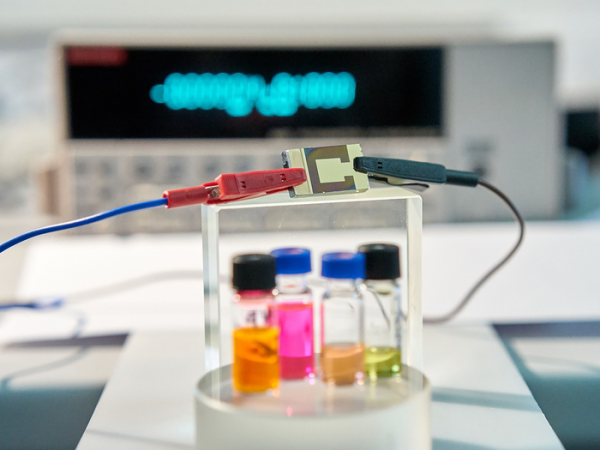Climate change and its impacts are turning more and more apparent, and solar cells with the ability to transform the sun’s energy into electricity will have a major role in the world’s future energy supply.

Cesium-containing triple-cation perovskite solar cell. Image Credit: Marius Franckevicius.
Semiconductor materials commonly used for making solar cells, like silicon, have to be synthesized through a high-cost process to prevent defects inside their crystal structure that impact the functionality. However, metal-halide perovskite semiconductors have turned out to be an inexpensive alternative class of materials, thanks to their superior and tunable functionality, along with easy processability.
Researchers have now come up with a road map for organic-inorganic hybrid perovskite semiconductors and devices. The study has been published in APL Materials, from AIP Publishing.
It is possible to process perovskite semiconductors from solution, and the desired film can be formed by coating or simply painting a semiconductor ink over surfaces. This can be added to semiconductor devices like light-emitting diodes or solar cells.
For many years, solution-processed semiconductors were viewed as unable to deliver the same functionality as specially grown crystalline semiconductors. The reason behind this thinking was that simple solution processing will inherently lead to a relative high number of defects within the formed crystal structure, which can negatively affect its functionality.
Lukas Schmidt-Mende, Study Co-Author, University of Konstanz
Organic-inorganic hybrid perovskites have been found to be highly defect-tolerant. Defects that form post-processing do not significantly impact device functionality, and as a first, hybrid perovskites are powering efficient solution-processed devices.
We can simply change the chemical composition of the perovskite to tune its bandgap, which allows us to change the absorption profile. This can be used to prepare light-emitting diodes at different wavelengths or to tune the perovskite material for tandem solar cells to optimize the absorption profile.
Lukas Schmidt-Mende, Study Co-Author, University of Konstanz
However, high defect tolerance “came as a surprise that needs to be better understood. Understanding the details will help to further optimize the material, perhaps to find other similar efficient alternatives and give us the chance to improve applications based on perovskite semiconductors,” he added.
According to the researchers, at present, perovskite devices present two main drawbacks. Firstly, the most efficient devices include lead, which is toxic, and measures to replace it with less poisonous elements have not been fully successful to date. Secondly, the life span of perovskite devices is less than that of silicon devices.
“Although the stability of perovskite devices has increased dramatically during the past few years, we still do not understand and have not overcome all of its degradation mechanisms,” noted Schmidt-Mende.
Several researchers have been working on solar cells and, with the probability of adjusting the bandgap, perovskites are appealing options for tandem applications in which they can be integrated with a standard silicon solar cell.
Other applications are light-emitting diodes, where the color of the light emitted can be tuned by adjusting the chemical composition of the perovskite. As for other semiconductors, the list of possible applications is long, and we are just beginning to understand this material and its potential.
Lukas Schmidt-Mende, Study Co-Author, University of Konstanz
Journal Reference:
Schmidt-Mende, L., et al. (2021) Roadmap on organic–inorganic hybrid perovskite semiconductors and devices. APL Materials. doi.org/10.1063/5.0047616.